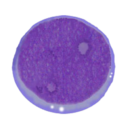Atypical patterns of primitive marker expression in acute myeloid leukaemia: Difference between revisions
From haematologyetc.co.uk
No edit summary |
No edit summary |
||
| Line 18: | Line 18: | ||
|colspan="1" style = "font-size:90%;|'''Acute promyelocytic leukaemia'''</br>Cells of APL can vary in size and granularity an will often express a range of side scatter features may resemble those of maturing granulocytic cells, similarly CD45 expression may be similar to maturing granulocytic cells. The distribution of cells will be abnormal however and may variably include cells with wide range light scatter features that differ from those of typical blast cells. It is important to distinguish APL blasts from reactive myeloid cells or (in some cases) from cells of MDS. Morphological examination is essential, but consider also the pattern of additional markers (see xxx). | |colspan="1" style = "font-size:90%;|'''Acute promyelocytic leukaemia'''</br>Cells of APL can vary in size and granularity an will often express a range of side scatter features may resemble those of maturing granulocytic cells, similarly CD45 expression may be similar to maturing granulocytic cells. The distribution of cells will be abnormal however and may variably include cells with wide range light scatter features that differ from those of typical blast cells. It is important to distinguish APL blasts from reactive myeloid cells or (in some cases) from cells of MDS. Morphological examination is essential, but consider also the pattern of additional markers (see xxx). | ||
|- | |- | ||
|colspan="1" style = "font-size:90%;"|'''Other patterns'''</br> | |colspan="1" style = "font-size:90%;"|'''Other patterns'''</br> While most frequently blast cells with myeloid differentiation form a relatively homogenous group with moderately weak CD45 expression, in some cases very weak expression or a wider spread of weak expression my be observed, often more closely resembling appearances of ALL or evn non-haematopoietic tumours.''' | ||
|- | |- | ||
|} | |} | ||
Revision as of 19:08, 14 December 2023
| Table: Less frequent patterns of primitive phenotype; |
|---|
| While blast cells typically cause low side scatter of light and have an expression of CD45 that is lower than normal lymphocytes or monocytes, atypical patterns may be encountered. The more frequent patterns are described below. |
| AML with monocytic differentiation In AML with monocytic maturation those primitive cells with more mature monocytic features may show higher side scatter (consistent with their size and cytological features) and some or all of the blast cells may also have high expression of CD45 (comparable with normal or CMML monocytes). Such cases may be difficult to distinguish from typical or transforming CMML. It is important to compare with clinical and morphological features to ensure appropriate classification (See details). |
| Acute promyelocytic leukaemia Cells of APL can vary in size and granularity an will often express a range of side scatter features may resemble those of maturing granulocytic cells, similarly CD45 expression may be similar to maturing granulocytic cells. The distribution of cells will be abnormal however and may variably include cells with wide range light scatter features that differ from those of typical blast cells. It is important to distinguish APL blasts from reactive myeloid cells or (in some cases) from cells of MDS. Morphological examination is essential, but consider also the pattern of additional markers (see xxx). |
| Other patterns While most frequently blast cells with myeloid differentiation form a relatively homogenous group with moderately weak CD45 expression, in some cases very weak expression or a wider spread of weak expression my be observed, often more closely resembling appearances of ALL or evn non-haematopoietic tumours. |
Blast cells with monocytic differentiation
These are often large with irregular nuclei and often sparse azurophilic granules. Those cells with more mature differentiation are still considered to be blast cells but may have immunophenotype similar to mature monocytes - correlation of morphology, clinical features and immunophenoptype may be necessary to accurately define such cells as blast cells.
